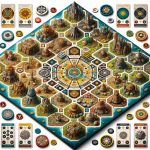Strategy board games have been a favorite pastime for many, combining strategic thinking, skillful planning, and a competitive edge. This Strategy Board Game Design Guide aims to provide aspiring game designers with essential insights and tips on creating their very own engaging and successful strategy board game. Whether you are a seasoned player looking to venture into game design or a newcomer interested in the world of tabletop gaming, this guide will take you through the process step by step.
In the ever-evolving landscape of tabletop gaming, strategy board games continue to grow in popularity, captivating players of all ages with their depth and complexity. From classic titles like Chess and Risk to modern favorites such as Settlers of Catan and Pandemic, these games offer a unique blend of tactics and decision-making that keep players coming back for more.
By understanding the core elements that make strategy board games so appealing, designers can craft their own creations that stand out in a crowded market.
To create a successful strategy board game, it is crucial to conduct thorough research and analysis of existing popular titles. By studying what makes these games enjoyable and engaging, designers can identify patterns, mechanics, and themes that resonate with players.
By incorporating elements from successful games while adding their unique twist, designers can strike the perfect balance between familiarity and innovation in their creations. With a solid foundation of knowledge about what works well in strategy board games, aspiring designers can embark on the journey of developing their game concept with confidence.
Understanding the Core Elements of Strategy Board Games
Strategy board games are a popular genre within the tabletop gaming community, known for their emphasis on strategic thinking, planning, and decision-making. To excel in designing strategy board games, it is crucial to understand the core elements that make these games engaging and challenging for players.
One key element is the concept of balance – ensuring that no single strategy or tactic dominates the game, allowing players to explore various paths to victory. Another essential element is player interaction, as meaningful player interactions create dynamic and engaging gameplay experiences.
In addition to balance and player interaction, resource management is a fundamental aspect of strategy board games. Players often have limited resources at their disposal, requiring them to make tough choices on how to allocate them efficiently. Whether it’s managing in-game currency, units, or actions, resource management adds depth and complexity to strategic decision-making in board games. Moreover, hidden information or asymmetrical player powers can introduce additional layers of strategy and replayability to a game.
When diving into the design process of a strategy board game, aspiring designers should carefully consider these core elements while brainstorming ideas and mechanics for their game. By understanding the importance of balance, player interaction, resource management, and other key elements, designers can create an engaging and challenging gameplay experience that will resonate with players. Integrating these elements thoughtfully into the overall game design will elevate the quality of the end product and set it apart in a competitive market.
| Core Elements | Importance |
|---|---|
| Balance | Ensures diverse strategies |
| Player Interaction | Creates dynamic gameplay |
| Resource Management | Adds depth and complexity |
Research and Analysis of Existing Successful Strategy Board Games
When embarking on the journey of designing a strategy board game, it is essential to conduct thorough research and analysis of existing successful strategy board games in the market. By studying these games, designers can gain valuable insights into what makes a game engaging, strategic, and enjoyable for players. Analyzing a variety of games from different genres can help designers identify common elements that contribute to the success of such games.
One key aspect to consider during this research phase is understanding the target audience for strategy board games. Different demographics have varying preferences when it comes to gameplay mechanics, themes, complexity levels, and player interaction. By examining how successful strategy board games cater to their specific target audience, designers can tailor their own game to appeal to a similar player base.
Moreover, analyzing the competitive landscape of strategy board games can provide valuable information on current trends, popular mechanics, and market gaps that designers can capitalize on. By identifying both direct competitors and potential collaborators in the industry, aspiring game designers can position their own game effectively in the market. This strategic analysis lays a solid foundation for developing a unique concept and theme that will resonate with players seeking engaging strategic gameplay experiences.
| Aspect | Importance |
|---|---|
| Target Audience | Understand preferences and tailor game accordingly |
| Competitive Landscape | Identify trends and market gaps for positioning |
| Market Analysis | Gather insights on successful strategies |
Developing a Unique Concept and Theme for Your Strategy Board Game
When it comes to developing a strategy board game, one of the crucial steps is creating a unique concept and theme that will set your game apart from others in the market. The concept and theme of your game will not only attract players but also give them a sense of immersion and engagement throughout the gameplay.
To come up with a compelling concept, start by brainstorming ideas that resonate with your interests, passions, or influences. Consider different themes such as historical settings, futuristic worlds, fantasy realms, or even abstract concepts that can be translated into a captivating narrative for your game.
Once you have narrowed down your concept and theme, it is important to delve deeper into the details to flesh out the world and story of your strategy board game. Define the backstory, characters, factions, goals, and conflicts that will drive the gameplay experience for players.
Create a rich tapestry of lore and mythology that will resonate with both casual gamers and hardcore enthusiasts. The more depth and narrative you infuse into your game’s concept and theme, the more memorable and engaging it will be for players.
Furthermore, consider how you can incorporate innovative mechanics and gameplay elements that complement and enhance the theme of your strategy board game. Whether it’s resource management in a post-apocalyptic setting or asymmetrical player powers in a cosmic conflict, make sure that every aspect of your game design aligns with the overarching concept and theme.
By weaving together cohesive gameplay mechanics with a compelling narrative backdrop, you can create a truly immersive experience that captivates players from start to finish. A strong concept and theme are essential foundation pillars for any successful strategy board game design guide.
Designing the Game Mechanics and Rules for Strategic Gameplay
Designing the game mechanics and rules for a strategy board game is a crucial step in creating an engaging and challenging gameplay experience for players. Here are some key considerations to keep in mind when developing the mechanics and rules for your game:
- Define the victory conditions: Clearly outline the objectives that players must achieve to win the game. Whether it’s conquering territories, amassing wealth, or completing specific tasks, the victory conditions should be challenging yet achievable.
- Create strategic choices: Incorporate decision-making elements that require players to think critically and plan ahead. Offer various paths to victory and introduce trade-offs that force players to prioritize their actions.
- Balance randomness and skill: Find the right balance between luck and skill in your game. While some randomness can add excitement and variability, ensure that strategic decisions ultimately determine the outcome of the game.
Additionally, it’s essential to test your game mechanics thoroughly through playtesting with different groups of players. Observe how they interact with the mechanics, identify any potential loopholes or imbalances, and gather feedback on what aspects of the gameplay are enjoyable or frustrating.
Key Recommendations
- Iterate based on feedback: Be open to making changes to your game mechanics based on playtest feedback. Continuously refine and tweak the rules to enhance strategic depth and overall player experience.
- Ensure clarity and accessibility: Make sure that your game rules are clear, concise, and easy for players to understand. Consider including examples or visual aids to illustrate how different mechanics work in practice.
- Stay true to your theme: Align your game mechanics with the concept and theme of your strategy board game. The mechanics should enhance immersion in the theme while offering engaging strategic challenges.
By focusing on these aspects of designing game mechanics and rules for strategic gameplay, you can create a compelling strategy board game that offers depth, replayability, and enjoyment for both casual players and seasoned strategists alike.
Creating Engaging Components and Visuals for the Game Board
Choosing Components That Enhance Gameplay
When designing a strategy board game, it is crucial to carefully select components that not only enhance the gameplay but also immerse players in the theme of the game. From meeples and tokens to cards and dice, each component should serve a specific purpose in facilitating strategic decision-making and adding depth to the overall gaming experience.
For example, unique player pieces can help players differentiate their strategies on the board, while custom dice can introduce an element of randomness that spices up gameplay.
Designing Visually Appealing Game Boards
The game board is often the centerpiece of any strategy board game, serving as the visual anchor that guides players through the gameplay. When designing the game board, consider factors such as clarity, readability, and aesthetics.
A well-designed game board should clearly convey important information to players, such as victory conditions, resource allocation, and available actions. Additionally, incorporating thematic artwork and graphic design elements can elevate the visual appeal of the game board and immerse players in the world of your game.
Integrating Storytelling Elements
Beyond just being a functional playing surface, the game board can also be used as a storytelling tool to deepen player engagement. By integrating narrative elements into the layout of the board or through visual cues in components, designers can create a richer gameplay experience that resonates with players on an emotional level.
Whether through hidden surprises on the board or unfolding story arcs revealed through gameplay decisions, storytelling can add depth and replay value to your strategy board game design.
Playtesting and Iterating to Refine the Strategy Board Game Experience
Playtesting and iterating are crucial steps in the process of refining a strategy board game to ensure a memorable and engaging experience for players. Here are some key strategies to consider when conducting playtests and making necessary iterations:
- Organize playtesting sessions with various groups of individuals to gather diverse feedback on different aspects of the game, such as mechanics, balance, player interaction, and overall enjoyment.
- Encourage players to provide honest and constructive feedback by asking specific questions about their experience, what they enjoyed most, what could be improved, and if they felt engaged throughout the gameplay.
- Analyze the collected feedback carefully and identify common themes or issues that arise across multiple playtest sessions. Use this information to prioritize which areas of the game need immediate attention and refinement.
Taking the time to iterate on your strategy board game based on playtest feedback is essential for enhancing gameplay and ensuring that your game resonates with audiences. Here are some additional tips for effectively refining your game through iteration:
- Implement iterative changes gradually rather than overhauling entire systems at once. This allows you to evaluate the impact of each adjustment on gameplay without causing disruption or confusion among players.
- Keep track of all iterations made during the testing phase to maintain a clear record of modifications and their effects. This documentation will help you track the evolution of your game design and make informed decisions moving forward.
- Continue iterating and playtesting until you achieve a balanced, engaging, and rewarding gameplay experience that aligns with your initial vision for the strategy board game. Remember that iteration is an ongoing process that can lead to significant improvements over time.
By incorporating thorough playtesting and iterative refinement into your strategy board game design process, you can enhance the overall quality of your game and create a more compelling experience for players. Embrace feedback from playtesters as valuable insights that can guide you towards creating a successful strategy board game that captivates audiences.
Marketing and Promotion Strategies for Launching Your Strategy Board Game
Marketing and promoting your strategy board game is a crucial step in getting your game noticed by the target audience and ensuring its success in the market. Here are some effective strategies to consider when launching your strategy board game:
Utilize Social Media and Online Platforms
In today’s digital age, social media is a powerful tool for reaching a wide audience and generating buzz around your strategy board game. Utilize platforms like Facebook, Instagram, Twitter, and BoardGameGeek to promote your game, share updates, run contests or giveaways, and engage with potential players. Create engaging content such as gameplay tutorials, behind-the-scenes insights into the design process, and sneak peeks of the components to build anticipation among followers.
Attend Trade Shows and Gaming Conventions
Participating in trade shows and gaming conventions is a great way to showcase your strategy board game to industry professionals, fellow designers, enthusiasts, and potential buyers. Consider setting up a demo booth or hosting playtest sessions to allow attendees to experience firsthand what makes your game unique. Networking at these events can also open up opportunities for collaborations with publishers or distributors who may be interested in helping bring your game to market.
Crowdfunding Campaigns
Launching a crowdfunding campaign on platforms like Kickstarter or Indiegogo can help you raise funds for production while generating interest and pre-orders for your strategy board game. A well-executed campaign with compelling visuals, engaging videos, detailed gameplay descriptions, and attractive reward tiers can attract backers and help build a community around your game. Be sure to promote your campaign through various channels, engage with backers regularly, and deliver on promises to create trust and loyalty among supporters.
Resources and Tools for Aspiring Strategy Board Game Designers
In the world of board game design, having access to the right resources and tools can make a significant difference in the success of your strategy board game. Aspiring designers can take advantage of a variety of resources to enhance their skills and bring their creative visions to life.
One essential resource for aspiring strategy board game designers is online communities and forums dedicated to tabletop gaming. These platforms provide valuable insights, feedback, and support from experienced designers and players. Engaging with these communities can help designers stay up-to-date on industry trends, learn from others’ experiences, and build a network of like-minded individuals.
Additionally, utilizing digital tools such as game design software and graphic design programs can streamline the development process of a strategy board game. These tools enable designers to create prototypes, test mechanics, and visualize their concepts more efficiently. By leveraging technology, aspiring designers can bring their ideas to fruition faster and with greater precision. Remember, the journey of designing a successful strategy board game is not just about creativity but also about utilizing the right resources effectively.
Frequently Asked Questions
How to Design My Own Board Game?
Designing your own board game can be a creative and rewarding process. Start by brainstorming the theme, mechanics, and objectives of the game. Consider what makes a game fun and engaging for players.
Create a prototype to test the gameplay and gather feedback for necessary improvements. Once you have refined your game, consider components like cards, tokens, and board design to enhance the overall experience.
What Makes a Board Game Strategic?
A strategic board game is characterized by requiring players to think critically, plan ahead, and make decisions that impact the outcome of the game. Strategic games often involve elements like resource management, player interaction, and variable paths to victory.
The depth of choices available to players and the ability to adapt your strategy based on opponents’ moves are key aspects that make a board game strategic.
How Do You Make a Good Strategy Game?
Making a good strategy game involves balancing complexity with accessibility, providing meaningful choices for players, and creating a dynamic playing experience. A well-designed strategy game should offer multiple paths to victory without overwhelming players with too many options. The right amount of randomness can add excitement while still allowing skillful play to shine through.
Playtesting with diverse groups of people can help identify any balance issues or unintended strategies that need adjustment. Ultimately, a good strategy game should challenge players intellectually while also being enjoyable and engaging throughout gameplay.

I love playing all kinds of games – from classics like Monopoly to modern favourites like Ticket to Ride.
I created this blog as a way to share my love of board games with others, and provide information on the latest releases and news in the industry.





